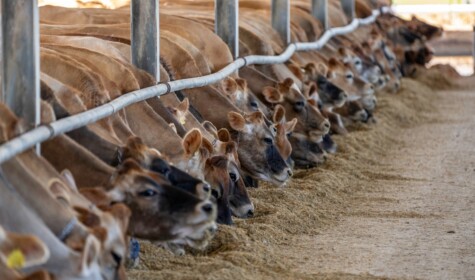Marianne Landzettel explores how COVID-19 is impacting the US industrial livestock sector, in particular the slaughtering and processing facilities which have become increasingly centralised over the years. Her piece highlights the need for a shift away from intensive farming and towards relocalised and diversified food systems.
In the second half of March, when record numbers of deaths in New York City from COVID-19 dominated the headlines, all seemed fine in the Midwest. ‘Social distancing is our way of life,’ joked a farmer from Nebraska. But what may be true for farmers, certainly doesn’t apply to workers in slaughter facilities and meat packing plants.
The first facilities that had to be closed because of COVID-19 outbreaks were the JBS USA plant in Souderton, Pennsylvania, where on a normal day 2,500 head of cattle are slaughtered, followed by a Cargill meat packing plant in Hazelton that employs 900 workers. Since then, the bad news keeps coming – JBS closed its beef facility in Greely, Colorado where 6,000 employees slaughtered 5,400 heads of cattle a day.
The number of workers in these facilities who have died of COVID-19 is increasing daily. On the 20th April, JBS announced the closure of its pork production plant in Worthington, Minnesota, where 2,000 workers usually process 20,000 pigs a day. Tyson Foods closed plants in Iowa and Nebraska, National Beef shut down its packing unit in Iowa and a Smithfield plant in Sioux Falls in South Dakota became the largest COVID-19 hotspot in the US: out of 3,700 employees, 16% tested positive. The eight-story facility which normally operates around the clock, producing about 5% of all pork in the US, remains closed.
Chicken processing plants, too, have been shut down, with a Tyson facility in the state of Georgia reporting four deaths from COVID-19. According to figures released by the USDA, 22% fewer cattle and 6% fewer pigs were being slaughtered, compared to the same period last year. This will soon be felt downstream in the supply chain: customers will probably see meat shortages in supermarkets and the pork, beef and chicken that will be available is going to be more expensive.
To have staff infected by a fast spreading virus would always be a huge problem for any company or processing facility. The COVID-19 crisis highlights just how vulnerable the system is, relying on industrial-scale slaughter facilities that kill tens of thousands of animals a day, with processing units working at break-neck speed. This is the elephant in the room and COVID-19 is evidence of industrial agriculture’s fundamental unsustainability – it is not fit for purpose. A food system capable of feeding us all must be based on diverse farms and localised infrastructure.
Working conditions in slaughter facilities that kill thousands of pigs or heads of cattle in a day, create a hotbed for the spread of the virus. In most plants, masks and other protective gear seem to have been in short supply or not available at all. Companies are now trying to erect barriers between workstations, but often workers stand shoulder to shoulder and some jobs involve at least two people working closely together – for example the person slicing open a pig carcass and the worker removing the entrails. ‘If you space people out, you reduce productivity,’ William Schaffner, professor of infectious diseases at Vanderbilt University’s medical school told the New York Times (NYT). The same goes for speed. For years, the big meat processors have fought for increased line speeds. Several companies got waivers from the USDA which allowed them to raise the line speed from 140 to 175 birds a minute; pork plants with an exemption are allowed to go beyond the maximum of 1,106 animals per hour. Both types of waivers are being contested in court by workers’ rights and food safety advocates because the increased line speeds also dramatically increase the risk of serious injuries.
Workers in meat processing plants are very often (legal or illegal) migrants, or they are in the US on a limited work visa. Reportedly, 80 different languages were spoken at the Smithfield plant in Sioux Falls. Most workers will live in cramped conditions and be under huge pressure to continue working in order not to lose their jobs. Social distancing and self-isolation will be difficult, many will be reluctant to seek medical help. Some facilities offered cash premiums for workers who don’t miss a day’s work until June.
As the virus spreads and more and more plants close, farmers suffer enormous financial losses. Over the last decades, the meat industry has seen wave after wave of consolidation. According to the NYT, there are now only about 800 federally inspected slaughterhouses left in the US. In the cattle industry, 98% of slaughter is being done in just 50 plants. ‘Slaughterhouses are a critical bottleneck in the system,’ the NYT quotes Julie Niederhoff, an associate professor of supply chain management at Syracuse University. ‘When they go down, we are in trouble.’ For meat producers, the situation is already dire. The pork industry faces $5 billion in losses due to COVID-19. Intensive production systems run on a tight schedule: farmers are contracted to deliver a specific number of pigs, at a target weight and specific time. Timing is essential because another producer will have the next set of weaners ready for the feeding barns. It’s costly if farmers have to feed animals longer, and further, there isn’t the space for new weaners. When barns become overcrowded, the only option is to euthanize the pigs. The same goes for chickens. A contract egg farmer in Minnesota was told on 22nd April, that the 61,000 chickens in his barn would be killed which will probably mean the end of his business too. As with the pigs, the problems were not on the farm but further down the line: in this instance with the Cargill Inc fluid egg plant that the farm supplied, which was shut down.
The cattle industry fares little better. In feedlots, space may not be the worst problem, but additional feed costs are – at a time when meat processors will buy fewer cattle at lower prices. ‘There is a monopoly with four big packers – JBS, National Beef (owned by Marfrig), Tyson and Cargill – not only controlling the market, but paying cattlemen whatever they want for [their] product. These four packers process approximately 80% of the beef in the US,’ says the Colorado livestock auction owner/operator Jerry Nine.
The domination of large-scale abattoirs in the US has severely impacted small- and medium-scale farmers, leaving few slaughtering options. While some notable farmers like Joel Salatin and Will Harris have solved the slaughter issue by building their own on-site abattoirs, there is still a significant need for more smaller-scale and mobile abattoirs. If farmers had these options more readily available, the situation would be much more manageable. The scale and speed at which smaller abattoirs work, allows for better animal welfare and food safety procedures, as well as a safer working environment.
The coronavirus pandemic shines a spotlight on the failings of industrial agriculture, especially factory farming and the lack of a localised infrastructure and the reliance on huge processing units. This not only puts farm profitability at risk, but also our health and welfare; it puts food security in jeopardy as the current waste of resources will eventually show up as shortages, higher food prices and most probably even greater consolidation within the food industry.



